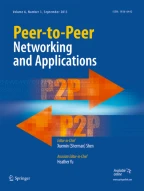Abstract
Data sharing plays an essential role in many of the mobile ad-hoc network (MANET) applications that exhibits collaborative behavior. In such applications, replication is used as a foremost and fundamental technique to improve data availability. However, due to the dynamic nature of the network, data replication becomes more intricate in MANET. To alleviate this problem, we have proposed a mechanism which not only enhances data accessibility, replicates data in a minimum number of nodes, relocates shared data on the prediction of mobility of replica holder and in addition, data can be accessed by any node in a minimum number of hops. In our approach, we have prefaced mathematical concept known as minimum dominating set and sub graph centrality principle to decide the number of replicas both in static and dynamic environment. Simulation results when compared with the existing mechanisms shows that the response time or data access delay is reduced, client can access the data from the server in a minimum number of hops, and consequently the number of forwarded messages to access the data are greatly reduced thus making our network energy efficient.
Similar content being viewed by others
References
Siva Ram Murthy C, Manoj BS (2007) “Ad hoc Wireless networks, Architecture and Protocols”, Second edition Pearson Edition
Marcel C Castro et al. (2010) “Peer to Peer Overlay in mobile ad hoc networks”, Handbook of Peer-to-Peer Networking,, Volume . ISBN 978-0-387-09750-3. Springer Science + Media, LLC, p. 1045
Charli Y, Saumitra M.Das, Himabindu Purcha (2002) “Exploiting the synergy between peer to peer and mobile ad hoc networks”, ECE Technical Reports. Paper 167
De Moralis C, Agarwal DP (2002) “Mobile ad hoc networking”, Course material, OBR Research Center for Distributed and Mobile Computing.
Derhab A, Badache N (2009) “Data replication protocols for mobile ad hoc networks, a survey and taxonomy”. IEEE Commun Surv Tutor 2(2):33–51, Addison Wesley, Massachusetts
Padmanaban, Gruenwald le (2008) “A survey of data replication technique for mobile ad hoc networks databases”, Springer link. VLDB J 17:1143–1164
Padmanabhan P, Gruenwald le (2006) “Managing data replication in mobile ad hoc networks”, In Proceedings of IEEE Xplore, International conference on Collaborative computing: network, Applications and Work sharing
Moussaovi S, Gueuoimi M, Badache N (2006) “Data Replication in Mobile Ad hoc Networks”, Second International Conference on Mobile ad hoc and sensor networks". Proc Lect Notes Comput Sci 4325:685–697, Springer link-verlag
Xiao C (2007) “Data replication approaches for ad hoc networks satisfying the time constraints”. Int J Parallel Emergent Distrib Syst 22(3):149–161
Moussaoui S, Badache N, Gueuoimi M (2005) “Two phase replication approach for MANETs”. Int J Adhoc Ubiquit Comput 4(5):292–303
Atsan E, and Ozkasap O (2007) “Applicability of eigen vector centrality principle to data replication in MANET”, In Proc. IEEE Xplore, International symposium on Computer and Information Sciences
Hara T, Loh YH, Nishio S (2003) “Data replication methods based on the stability of radio links in ad hoc networks”, In Proc. IEEE Xplore, International workshop on database and Expert Systems
Zhang Y, Yin LZ, Zhao J, Cao G (2012) “Balancing the trade-off between query delay and data availability in MANETs”. IEEE Trans Parallel Distrib Syst 23(4):643–650, 0nline:18 August 2011
Choi JH, Shim KS, Lee S, Wu KL (2012) “Handling selfishness in Replica allocation over a mobile ad hoc networks”. IEEE Trans Mob Comput 11(2):278–291
Narsingh Deo (1974) “Graph Theory with Applications to Engineering and Computer Science”, Prentice Hall
Estrada E, Rodriguez JA (2005) “Subgraph Centrality in Complex Networks”, Phys Rev E Am Phys Soc J Vol.no71: Issue 5
Morgan MJ, Grout Vic (2008) “Finding Optimal Solutions to Backbone Minimization Problems Using Mixed Integer Programming”, Seventh International Conference (INC 2008), Plymouth, UK
Wireless Network Simulator in Matlab, http://www.Wireless-matlab.sourceforge.net.
Ed. Scheineerman, Matgraph, “A graph Theory Toolbox for MATLAB” http://www.ams.jhu.edu
MATLAB, “The Language of Technical Computing”, http://www.mathworks.com
Estrada’s sub graph centrality, communicability, community detection http://intersci.ss.uci.edu/wiki/index.php/
Author information
Authors and Affiliations
Corresponding author
Rights and permissions
About this article
Cite this article
Pushpalatha, M., Ramarao, T. & Venkataraman, R. Applicability of sub graph centrality to improve data accessibility among peers in MANETs. Peer-to-Peer Netw. Appl. 7, 129–146 (2014). https://doi.org/10.1007/s12083-012-0187-x
Received:
Accepted:
Published:
Issue Date:
DOI: https://doi.org/10.1007/s12083-012-0187-x
